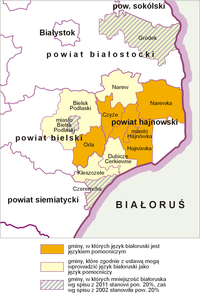Bilingual communes in Poland
Nowadays, Bilingual communes in Poland is a recurring theme that has captured the attention of many people around the world. Since its emergence, it has generated debate and controversy, positioning itself as a key point on the public agenda. As interest in Bilingual communes in Poland grows, so does the need to understand its many facets and consequences. In this article, we will explore the various dimensions of Bilingual communes in Poland, analyzing its impact in different areas and offering a complete overview of its relevance today.
The bilingual status of gminas (municipalities) in Poland is regulated by the Act of 6 January 2005 on National and Ethnic Minorities and on the Regional Languages, which permits certain gminas with significant linguistic minorities to introduce a second, auxiliary language to be used in official contexts alongside Polish. So far 44 gminas have done this:
Polish/German

Polish/German bilingual gminas (Gemeinden) in
- Opole Voivodeship (28 municipalities)
- Gmina Biała / Gemeinde Zülz (since 06.03.2006)
- Gmina Bierawa / Gemeinde Birawa (since 23.04.2007)
- Gmina Chrząstowice / Gemeinde Chronstau (since 25.01.2006)
- Gmina Cisek / Gemeinde Czissek
- Gmina Dobrodzień / Gemeinde Guttentag (since 13.05.2009)
- Gmina Dobrzeń Wielki / Gemeinde Groß Döbern (since 22.04.2009)
- Gmina Głogówek / Gemeinde Oberglogau (since 22.04.2009)
- Gmina Gogolin / Gemeinde Gogolin
- Gmina Izbicko / Gemeinde Stubendorf (since 06.03.2006)
- Gmina Jemielnica / Gemeinde Himmelwitz (since 28.08.2006)
- Gmina Kolonowskie / Gemeinde Colonnowska (since 22.09.2006)
- Gmina Komprachcice / Gemeinde Comprachtschütz (since 04.06.2009)
- Gmina Lasowice Wielkie / Gemeinde Gross Lassowitz (since 18.10.2006)
- Gmina Leśnica / Gemeinde Leschnitz (since 17.05.2006)
- Gmina Łubniany / Gemeinde Lugnian
- Gmina Murów / Gemeinde Murow (since 22.04.2009)
- Gmina Pawłowiczki / Gemeinde Gnadenfeld
- Gmina Polska Cerekiew / Gemeinde Groß Neukirch
- Gmina Popielów / Gemeinde Poppelau
- Gmina Prószków / Gemeinde Proskau (since 11.07.2006)
- Gmina Radłów / Gemeinde Radlau (since 25.01.2006)
- Gmina Reńska Wieś / Gemeinde Reinschdorf (since 26.10.2006)
- Gmina Strzeleczki / Gemeinde Klein Strehlitz (since 17.05.2006)
- Gmina Tarnów Opolski / Gemeinde Tarnau (since 15.02.2007)
- Gmina Turawa / Gemeinde Turawa (since 12.09.2008)
- Gmina Ujazd / Gemeinde Ujest (since 28.08.2006)
- Gmina Walce / Gemeinde Walzen (since 04.04.2006)
- Gmina Zębowice / Gemeinde Zembowitz (since 23.10.2007)
- Silesian Voivodeship (3 municipalities)
- Gmina Krzanowice / Gemeinde Kranowitz
- Gmina Rudnik / Gemeinde Rudnik
- Gmina Sośnicowice / Gemeinde Kieferstädtel
Other gminas in Opole Voivodeship and Silesian Voivodeship which would be permitted by the Act to make German an auxiliary language are Olesno and Pawłowiczki.
Polish/Kashubian

Polish/Kashubian bilingual gminas in Pomeranian Voivodeship:
- Gmina Linia (Gmina Lëniô; since 23.04.2012)
- Gmina Luzino (Gmina Lëzëno; since 21.02.2014)
- Gmina Parchowo (Gmina Parchòwò; since 16.08.2006)
- Gmina Sierakowice (Gmina Serakòwice; since 23.10.2007)
- Gmina Żukowo (Gmina Żukòwò; since 17.07.2013)
Polish/Lithuanian
Polish/Lithuanian bilingual gmina in Podlaskie Voivodeship:
- Gmina Puńsk (Punsko valsčius; since 25 May 2006)
Polish/Belarusian

Polish/Belarusian bilingual gminas in Podlaskie Voivodeship:
- Hajnówka-urban gmina (Гайнаўка) on 3 December 2007
- Gmina Czyże (Гміна Чыжы) on 8 February 2010
- Gmina Hajnówka-rural gmina (Гміна Гайнаўка) on 28 May 2010
- Gmina Narewka (Гміна Нараўка) on 16 September 2009
- Gmina Orla (Гміна Орля) on 7 May 2009
Polish/Lemko
Polish/Lemko bilingual names of localities in Małopolskie Voivodeship:
- Gmina Gorlice: Bielanka
- Gmina Uście Gorlickie: Blechnarka, Gładyszów, Konieczna, Kunkowa, Nowica, Regietów, Ropki, Zdynia
Gallery
-
Polish/Lemko place-name sign in Bielanka
-
Polish/Kashubian street name sign in Jastarnia
-
Polish/Kashubian road sign with the village name (Dolina Jadwigi)
-
Bilingual Polish/Belarusian sign in Oleksze
-
Polish/German place-name sign in Kosorowice
References
- ^ "Map on page of Polish Commission on Standardization of Geographical Names" (PDF). Retrieved 20 June 2015.
External links
- Maciej Zych. Minority place names in Poland. United Nations Group of Experts in Geographical Names. Twenty-sixth session. Vienna 2–6 May 2011. Working Paper no. 3.
- List of minority place names in Poland according to Register of the communes where place-names in minority language are used provided by Ministry of Administration and Digitization as of April 9, 2019.




